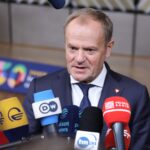Even though the return of Donald Trump as US president is creating great uncertainty and the international environment remains difficult, growth in most economies of Central, East and Southeast Europe will pick up in 2025—especially in the EU member states.
This is shown by the new winter forecast by the Vienna Institute for International Economic Studies (wiiw) for 23 countries of the region.
“However, this assumes that Trump does not immediately impose high tariffs on the EU and that he does not grant Putin an easy victory in Ukraine by abandoning the country and cutting military and financial aid to it,” says Richard Grieveson, deputy director of wiiw and lead author of the winter forecast. “We are assuming this scenario.”
For 2025, wiiw forecasts average growth of 2.8 per cent for the EU members of the region, a minimal downward revision of 0.1 percentage points compared to last autumn.
Growth in 2026 should be similar, at 2.7 per cent, which likewise represents a slight downward adjustment of 0.3 percentage points. This means that both this year and next, the EU members of Central, East and Southeast Europe are likely to grow at about twice the rate of the euro area (2025: 1.2 per cent; 2026: 1.4 per cent), thus continuing their economic catch-up process.
Industry in key countries of the region, such as Poland, Czechia, Slovakia, Hungary and Romania (which are closely intertwined with Germany), is struggling because of the ongoing recession in German manufacturing.
Poland the EU’s frontrunner
However, growth in those countries continues to be driven by strong private consumption, thanks to robust real wage increases. “People are spending the additional disposable income, which is boosting the economy,” explains Grieveson.
Poland will be the frontrunner in terms of growth among the eastern EU member states, both this year (3.5 per cent) and next (three per cent); it will be closely followed by Croatia (2025: 3.1 per cent; 2026: three per cent). The six countries of the Western Balkans will expand comparatively sharply, by an average of 3.5 per cent in 2025 and 2026.
The outlook for war-torn Ukraine is becoming somewhat gloomier. The Vienna Institute is forecasting growth of three per cent for 2025—a downward revision of 0.3 percentage points—although much will, of course, depend on Trump’s Ukraine policy.
In the case of aggressor Russia, last year’s robust growth (3.8 per cent) is likely to halve to just 1.8 per cent this year. The same will apply to the autocratically ruled Belarus, under President Alexander Lukashenko, which is closely bound up with the Russian war economy and is expected to grow by just two per cent in 2025, following growth of four per cent last year.
Donald Trump unchained is the major downside risk
The greatest downside risk to the forecast lies in an unrestrained policy approach by Donald Trump.
“Since the US has become by far the most important export market for the EU over the past decade, the negative impact of high US tariffs on European goods and services would also be significant for the Eastern European members and would be felt by them relatively soon,” says Grieveson.
While direct trade flows between the region and America are limited, lower US demand for European industrial products and reduced investment could have a severe impact on Central and Eastern Europe.
And there is Trump’s unpredictable Ukraine policy, which could hit the region’s economy hard.
“If Ukraine were to receive no more help from Washington and be defeated militarily, that would severely damage the image of the West, demoralise and discredit NATO and encourage Putin to test the alliance’s mutual defence clause,” warns Grieveson.
“A large wave of refugees from Ukraine to the entire EU would probably be the result, and there would also be the possibility of a sharp rise in global food prices, which could lead to social and political unrest.”
Ukraine’s economy is in jeopardy
Although wiiw does not assume this negative scenario, and although Ukraine’s economy has shown astonishing resilience so far, the economic outlook does appear increasingly uncertain.
For 2025, wiiw forecasts growth of three per cent for the country, a downward revision of 0.3 percentage points compared to last autumn.
Ukraine is increasingly suffering from the systematic destruction of its energy infrastructure by Russian air strikes and from a worsening labour shortage. The drought last summer also caused agricultural exports to fall and food prices to rise.
In order to combat rising inflation, the central bank has suspended the easing of monetary policy and has raised key interest rates to 14.5 per cent. The tightening of monetary policy is likely to further dampen economic growth. Nevertheless, it should pick up to five in 2026.
“However, if Donald Trump forces Ukraine into a dictated peace without credible security guarantees and significantly reduces financial and military support, this will cloud the economic outlook and deter investors,” says Olga Pindyuk, Ukraine expert at wiiw.
Photo by Adam Borkowski on Unsplash.







